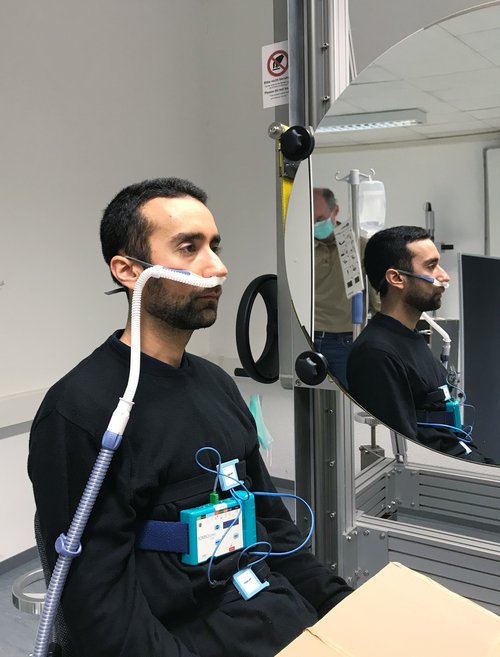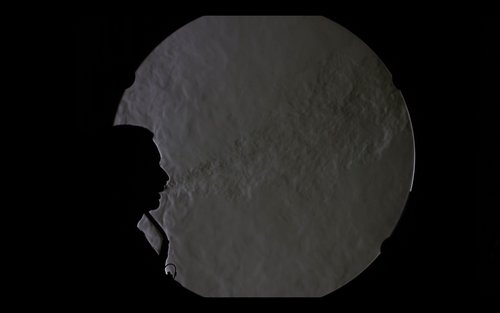COVID-19 Prevention: Investigating the Risk of Infection from Ventilated Patients
Together with intensive care physicians at the Kloster Grafschaft-Fachkrankenhaus, scientists at the Bauhaus-Universität Weimar are investigating how virus-infected air spreads among ventilated patients. The goal is to prevent the spread of infection in hospitals and care homes.
What happens when patients can no longer breathe on their own and need to be supported by machines? How far does infected air spread throughout a room? And what safety precautions do medical and nursing staff need to take? Respiratory specialists Dr. Dominic Dellweg and Dr. Jens Kerl together with Dr.-Ing. Conrad Völker, Amayu Wakoya Gena, and Dr. Hayder Alsaad from the Department of Building Physics are investigating these questions. Their research focusses on the procedures that are carried out on patients who are seriously ill with the coronavirus and require either full-face or nasal cannula breathing support (Nasal High-Flow Therapy).
Nasal High-Flow Therapy
In addition to conventional oxygen therapy using full-face masks, Nasal High-Flow Therapy (NHF) has become a widely accepted treatment for patients of all ages in recent years as it may prevent the need for invasive ventilation, which is associated with a high mortality rate in cases of the coronavirus. In NHF, the patient is administered warmed, humid, oxygen-enriched air through a nasal cannula. This forms strong air currents in front of the patient’s face.
The Air We Breathe Can Spread up to Four Metres across a Room
»Until now, it was uncertain how far exhaled air infected with pathogens could spread in a patient’s rooms with different airflows, putting medical staff at risk«, explains PD Dr. med. Dominic Dellweg, head physician of Pneumology I at the Fachkrankenhaus Kloster Grafschaft GmbH in Schmallenberg, one of the largest respiratory therapy centres in Germany. The experiment, which took place in the Schlieren Lab at the Bauhaus-Universität Weimar yielded new findings: With the help of the Schlieren mirror, the Weimar scientists are able to make even the smallest air currents in a room visible. Based on these details, the test series was repeated in studies with the physicians from North Rhine-Westphalia and modified to study various risk situations that occur in everyday intensive care medicine.
These studies showed that the range of infected exhaled air grows with increased ventilation pressure and can spread up to four metres across a room. Because of the potential increase in droplet-borne disease transmission, the safety distance was adjusted accordingly.
The study was conducted on a healthy male subject seated in front of the mirror and outfitted with an NHF therapy device. The subject’s breath was monitored with a standard sleep lab polygraph. The study looked at three scenarios with different NHF rates in addition to a comparison unassisted breathing scenario. The maximum aerosol dispersion for unassisted breathing without NHF was 0.99 metres; an NHF of 20 litres per minute resulted in a maximum dispersion of 2.18 m; an NHF of 40 l/min, 2.92 m; and an NHF of 60 l/min, 4.1 m.
It is important to note, however, that the Schlieren imaging technique shows only the density of fluids, in this case the exhalation cloud. This means that no conclusions can be made on the size and distribution of the various particles in the breath. Thus, further research is necessary to determine whether NHF simply increases the volume of the exhaled air, or whether NHF increases the absolute amount of virus expelled from the lungs.
The peer-reviewed study was recently accepted for publication in the prestigious journal Critical Care Medicine: https://journals.lww.com/ccmjournal/Abstract/9000/Exhalation_Spreading_During_Nasal_High_Flow.95277.aspx
Recently on 14 April 2021, researchers from the Department of Building Physics at the Bauhaus-Universität Weimar were awarded the 2021 »Thüringer Forschungspreis« in the category of »Angewandte Forschung« (applied research) for their work on »Optische Schlierenverfahren zur Visualisierung von Raumluftströmungen« (Schlieren method for the visualization of indoor airflow).

Schlierenspiegel zeigt Ausbreitung von Atemluft bei der Beatmung
Click the Play button to load and view external content from Vimeo.com.
Automatically load and view external content from Vimeo.com (You can change this setting at any time via our »Data protection policy«.)


